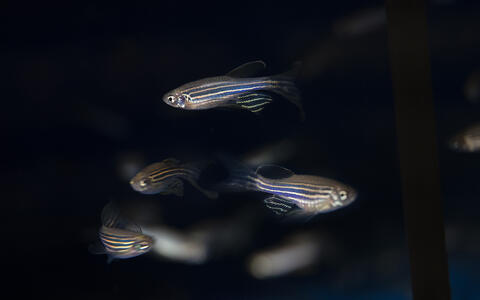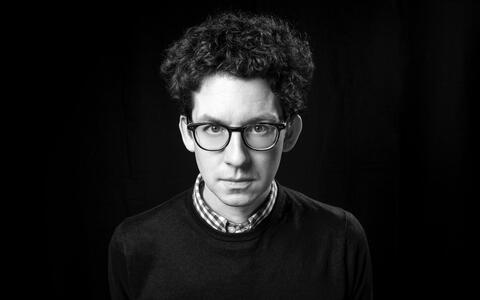How cells make decisions
The zebrafish is a remarkable animal, as many of its organs are able to make a full recovery following an injury. If a zebrafish has a heart attack, for example, rigid scar tissue develops just as it does in humans. But unlike in humans, this scarring disappears again after a few weeks. “Humans are not particularly good at regenerating organs,” says Jan Philipp Junker, who uses the zebrafish as a model organism in his laboratory at the Berlin Institute for Medical Systems Biology of the Max Delbrück Center (MDC). He investigates, for example, what mechanisms are active in the cells of this fish when an organ is in recovery. “In the long term, this knowledge could help us find ways to support the same ability in humans,” says the scientist.
The zebrafish is used as model organism in the laboratory of Jan-Philipp Junker.
However, a lot more basic research is required before we reach that point. In his research group on Quantitative Developmental Biology, Jan Philipp Junker and his team spend their days trying to understand how cells make fundamental decisions. This also involves analyzing their family history. Junker has developed a technology called LINNAEUS, which he presented in 2018 in the journal Nature Biotechnology. This technology enables scientists to simultaneously determine the lineage and cell type of thousands of individual cells from an organism.
Jan Philipp Junker, who is 39 years old with brown glasses and dark curly hair, opens his laptop in his office in Berlin’s central Mitte district. A colorful image appears on the screen, which, with its many binary branches, looks like it could represent the actual family tree of a member of nobility. But instead of displaying photos and names, this tree is full of circular pie charts containing segments of different colors. Using these, the researcher can see which cells are related to each other. These may be cells from the brain, the intestines or the heart. And knowing the origin of the cells tells him something about how the different lineage trees are created.
When lineage trees go awry
Junker would like to understand the various paths that lead to a functioning organism. “We assume that cell lineage trees are flexible, but we do not yet know to what extent,” he explains. Whereas in more primitive life forms, such as the nematode worm, each cell’s lineage is precisely defined, this is not the case in mammals such as mice or humans. He is therefore interested in questions such as: How variable are these lineage trees? And how do the cells react to perturbations?
Many diseases are based on perturbations in these lineage trees. The best known example is cancer, where control over cell division is lost. But diseases such as diabetes or autism are also the result of too many or too few cells of a certain cell type. A better understanding of the lineage trees and the fundamental decision-making processes in cells could lead to the development of new therapies in the future.
Jan-Philipp Junker.
Born in Stuttgart, Junker studied physics at the Technical University of Munich, where he also completed his PhD. Even as a child, Junker was especially interested in everything that could not be directly touched or seen. First, it was the universe with its most distant planets. He only started to show an interest in biology at school when things got molecular. “I’ve always been very interested in the hidden and the inaccessible,” he says. “It fascinates me to discover patterns and systems within it.”
This fascination led him not only to the natural sciences, but also – in his free time – to art. His office not only displays a golden microscope on one of the shelves, but also a large-format poster of an exhibition by the artist Gerhard Richter that hangs above his desk. He enjoys books by authors like Paul Auster and George Saunders. “After all,” he says, “literature is also about the hidden – that which is hidden in the human psyche.”
Don’t throw in the towel
His research group is still young and the internal organization complex. He enjoys wandering through the laboratories, discussing projects with his colleagues. “That’s the reason I do this job,” he says. As a group leader, he wants to be a mentor – to take the outside perspective when someone gets stuck in his or her work and help the scientists to decide whether or not a change in direction is necessary. “As a scientist, the thing you’re putting energy into does not always bear the desired fruit,” he says.
But persevering and not giving up has also helped him in the past. While researching his LINNAEUS technique, for example, he learned that other groups, including some from Harvard, were working on the same topic. “That was a little awkward, but it paid off not throwing in the towel,” he says. In the end, he worked just as quickly as the other scientists and coordinated with them so that they submitted their papers simultaneously.
His stay in the United States has also given him self-confidence in this respect. In 2010, he started working at the Massachusetts Institute of Technology (MIT) in Cambridge. “Being in the Boston area, this epicenter of science where a world specialist is often just a few streets away, is naturally very awe-inspiring,” he says. “But there is no need to be intimidated.” He followed his MIT professor to the Hubrecht Institute in the Netherlands in 2013, where he developed a technique called tomo-seq, which enables scientists to obtain genome-wide expression data with spatial resolution. This means knowing not only which genes are active at a given time, but also in which organs or tissues.
The first days in his own laboratory
Junker has now led his own research group at the MDC for four years. He can still remember clearly the first days as head of his own laboratory. He had just moved to Berlin from Utrecht – boxes were piled up at home and his new laboratory was still completely empty. First he had to purchase equipment, apply for funds and, above all, recruit good scientists. “It was a lot of responsibility all at once,” he says, adding that it is not so easy to recognize the potential of a future employee in the limited time frame of a job interview.
But today he can say that he succeeded. His laboratory has made a name for itself, and Junker is often traveling the world and being invited to speak at international conferences. Since 2016, Junker is one of the young, emerging researchers supported by the European Research Council (ERC) through an ERC Starting Grant. This year, he was also included in the EMBO Young Investigators program for researchers under 40. This program provides not only financial support, but also the opportunity to actively network with other European scientists.
And a year and a half ago, Junker encountered another challenge in Berlin when he became a father for the first time. “Since then, of course, I have also been trying to balance work and family life,” he says, which is no easy task for an up-and-coming scientist. As kindergarten places are scarce, it was not possible to find somewhere in the immediate vicinity, so he makes a ten-kilometer detour every morning to take his little boy to daycare. “This takes up a lot of time, but I go by bike and see it as my exercise for the day,” he says. That way, he is doing something for his heart and health at the same time. After all, humans are not zebrafish
Text:
Alice Ahlers
Further information:
Junker Lab
Press release Jan Philipp Junker named EMBO Young Investigator







